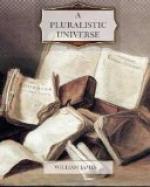The organ that gives us most trouble is the brain. All the consciousness we directly know seems tied to brains.—Can there be consciousness, we ask, where there is no brain? But our brain, which primarily serves to correlate our muscular reactions with the external objects on which we depend, performs a function which the earth performs in an entirely different way. She has no proper muscles or limbs of her own, and the only objects external to her are the other stars. To these her whole mass reacts by most exquisite alterations in its total gait, and by still more exquisite vibratory responses in its substance. Her ocean reflects the lights of heaven as in a mighty mirror, her atmosphere refracts them like a monstrous lens, the clouds and snow-fields combine them into white, the woods and flowers disperse them into colors. Polarization, interference, absorption, awaken sensibilities in matter of which our senses are too coarse to take any note.
For these cosmic relations of hers, then, she no more needs a special brain than she needs eyes or ears. Our brains do indeed unify and correlate innumerable functions. Our eyes know nothing of sound, our ears nothing of light, but, having brains, we can feel sound and light together, and compare them. We account for this by the fibres which in the brain connect the optical with the acoustic centre, but just how these fibres bring together not only the sensations, but the centres, we fail to see. But if fibres are indeed all that is needed to do that trick, has not the earth pathways, by which you and I are physically continuous, more than enough to do for our two minds what the brain-fibres do for the sounds and sights in a single mind? Must every higher means of unification between things be a literal brain-fibre, and go by that name? Cannot the earth-mind know otherwise the contents of our minds together?
Fechner’s imagination, insisting on the differences as well as on the resemblances, thus tries to make our picture of the whole earth’s life more concrete. He revels in the thought of its perfections. To carry her precious freight through the hours and seasons what form could be more excellent than hers—being as it is horse, wheels, and wagon all in one. Think of her beauty—a shining ball, sky-blue and sun-lit over one half, the other bathed in starry night, reflecting the heavens from all her waters, myriads of lights and shadows in the folds of her mountains and windings of her valleys, she would be




